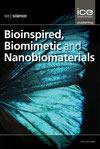Fabrication of anisotropic superhydrophobic surface based on the Nepenthes slippery zone
IF 0.6
4区 工程技术
Q4 ENGINEERING, BIOMEDICAL
引用次数: 0
Abstract
Depending on its highly evolved structures that consist of microscale lunate cells and nanoscale wax coverings, the slippery zone of Nepenthes alata shows significant anisotropic superhydrophobicity, which has gradually become the biomimetic prototype for designing superhydrophobic surfaces. In this study, the authors constructed the structures of the slippery zone into equidistantly distributed greenhouses and array of cylinders, therefore obtaining a biomimetic model of an anisotropic superhydrophobic surface. The greenhouses were printed using ultraviolet-cured material, via 3D printing, and then flake graphite was selected as a substitute for the array of cylinders (wax coverings) and was absorbed onto the printed greenhouses by using high-voltage electrostatic absorption technology. The contact/sliding angle was measured to verify the anisotropic superhydrophobic effect of the fabricated sample. The contact angle increases significantly with an increase in the greenhouse density (l/L value) and achieves a value of 152.6 ± 0.6° when l/L is 0.8, and the sliding angle toward bottom and top shows values of 3.07 ± 0.26° and 5.69 ± 0.24°, respectively. These results indicate that the fabricated sample has anisotropic superhydrophobicity. Therefore, this study provides a simple and low-cost approach for the biomimetic fabrication of anisotropic superhydrophobic surfaces.基于Nepenthes滑带的各向异性超疏水表面的制备
由于其由微尺度的月状细胞和纳米尺度的蜡覆盖层组成的高度进化的结构,蜈蚣草的滑带表现出显著的各向异性超疏水性,逐渐成为设计超疏水表面的仿生原型。在本研究中,作者将滑区结构构建为等距分布的温室和圆柱体阵列,从而获得了各向异性超疏水表面的仿生模型。温室使用紫外线固化材料,通过3D打印打印,然后选择片状石墨作为圆柱体阵列(蜡覆盖物)的替代品,并通过高压静电吸收技术吸收到打印的温室上。通过测量接触/滑动角来验证制备的样品的各向异性超疏水效果。接触角(l/ l值)随温室密度的增加而显著增大,当l/ l为0.8时达到152.6±0.6°,向下和向上滑动角分别达到3.07±0.26°和5.69±0.24°。结果表明,制备的样品具有各向异性超疏水性。因此,本研究为各向异性超疏水表面的仿生制备提供了一种简单、低成本的方法。
本文章由计算机程序翻译,如有差异,请以英文原文为准。
求助全文
约1分钟内获得全文
求助全文
来源期刊

Bioinspired Biomimetic and Nanobiomaterials
ENGINEERING, BIOMEDICAL-MATERIALS SCIENCE, BIOMATERIALS
CiteScore
2.20
自引率
0.00%
发文量
12
期刊介绍:
Bioinspired, biomimetic and nanobiomaterials are emerging as the most promising area of research within the area of biological materials science and engineering. The technological significance of this area is immense for applications as diverse as tissue engineering and drug delivery biosystems to biomimicked sensors and optical devices.
Bioinspired, Biomimetic and Nanobiomaterials provides a unique scholarly forum for discussion and reporting of structure sensitive functional properties of nature inspired materials.
 求助内容:
求助内容: 应助结果提醒方式:
应助结果提醒方式:


